2. 江西地质矿床勘查开发局赣西北大队, 九江 332000
2. Northwestern Jiangxi Geological Team, Bureau of Exploration and Development of Geology and Mineral Researches of Jiangxi Province, Jiujiang 332000, China
江西九瑞矿集区属长江中下游成矿带, 包括江西省西北部的九江市及瑞昌市周边地区。目前该矿集区的铜产量主要来自以矽卡岩型、块状硫化物型矿床为主的武山铜矿, 及以斑岩型、块状硫化物型矿床为主的城门山铜矿。近年来, 随着国家深部找矿战略以及整装勘查等工作的部署和展开, 在九瑞的许多成矿远景区, 如金鸡窝, 武山外围, 宝山等地, 已经取得了找矿的显著进展, 该区显示出了非常大的深部成矿远景。
山上湾矿区位于九瑞矿集区西南部的大浪(瀼) 水库附近, 位置如图 1所示, 矿区内有数条近东西向的石英闪长玢岩及花岗闪长斑岩岩脉, 前人和我们最近的工作均在该区的岩脉中, 以及与之接触的志留系粉砂岩中发现了铜矿化。山上湾有可能成为九瑞的一个新的成矿远景区。因此, 我们对这些浅成侵入岩脉开展了详细的U-Pb定年、矿物化学、主微量元素及Sr-Nd-Hf同位素的研究工作, 对岩石成因及成矿意义进行了初步探讨。

|
图 1 九瑞矿集区地质简图及山上湾矿区位置 Fig. 1 Geological sketch map of the Jiurui ore district and location of Shanshangwan area |
九瑞矿集区地处扬子板块北缘, 大别造山带以南, 是长江中下游成矿带的七个矿集区之一。该地区北西西向的基底断裂为一级控岩控矿构造, 沿该断裂由南东至北西依次分布有城门山、丁家山、武山、东雷湾和邓家山等岩株(图 1), 这些岩浆岩均与区内大中型矿床或不同程度的矿化有关, 构成了该区最主要的构造-岩浆-成矿带(黄恩邦等, 1990; 翟裕生等, 1992, 1999)。区内主要的侵入岩除花岗闪长斑岩外, 还分布有石英闪长玢岩、石英斑岩、花岗细晶岩和煌斑岩脉, 目前对这些岩浆岩侵入时代的研究表明, 九瑞地区的岩浆活动集中在138.2±1.8Ma至148.0±1.0Ma之间(Ding et al., 2006; Li et al., 2010; Yang et al., 2011; 蒋少涌等, 2008; 李亮和蒋少涌, 2009; 陈志洪等, 2011)。该区地层由包含多个轴向近平行, 并交替出现的背斜、向斜的复式褶皱所构成, 褶皱轴线从西到东由北东东向逐渐转至北东向, 总体为一向南东弯曲的弧形复式褶皱带(图 1)。除上述提到的岩株状岩浆岩外, 该区的岩脉则大多沿地层不整合面及层间薄弱面贯入式分布, 与组成复式褶皱的地层走向方向相一致, 构成了区内的次级构造-岩浆-成矿带。已有的研究将次级构造-岩浆-成矿带划分为五组, 自北西向南东有:1) 东雷湾-通江岭构造-岩浆-成矿亚带;2) 丫头山-宝山-夫山构造-岩浆-成矿亚带;3) 宋家湾-武山构造-岩浆-成矿亚带;4) 大浪-洋鸡山-丁家山构造-岩浆-成矿亚带;5) 长山-城门山构造-岩浆-成矿亚带(刘迅, 1990; 翟裕生等, 1992, 1999)。
山上湾矿区位于大浪-洋鸡山-丁家山构造-岩浆-成矿亚带的西端。该矿区地表出露有三条浅成侵入岩岩脉(图 2), 近东西向顺层侵入志留纪粉砂岩地层中。为便于区分和表述, 将三条岩脉按由南到北的顺序, 编号为岩体Ⅰ、Ⅱ和Ⅲ。二十世纪七八十年代赣西北地质队在山上湾最北部的岩体Ⅲ做了一些工作, 施工了10个左右的浅钻, 在岩体Ⅲ浅部发现有分散的Cu矿化, 不具备工业意义。已有的化探工作同时发现, 南部的岩体Ⅰ地表的金矿化异常很好, 浅部具有寻找与石英闪长玢岩有关的热液金矿的潜力。
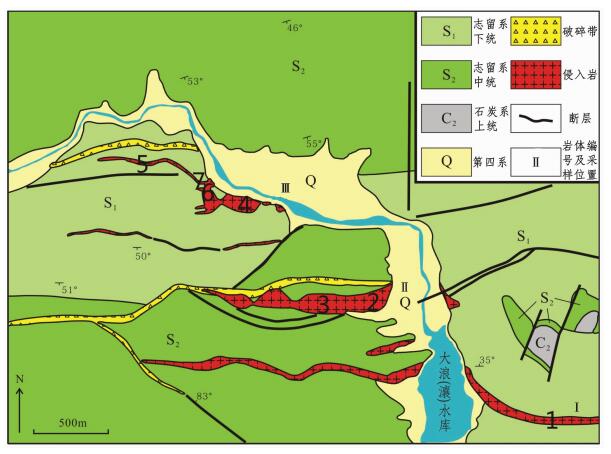
|
图 2 山上湾矿区地质简图及采样位置 Fig. 2 Geological sketch map and sample locations of the Shanshangwan area |
本文分析测试的7件岩石样品均来自于山上湾矿区地表露头, 样品对应的采集位置已在图 2中标出。样品SSW-1采自岩体Ⅰ, 灰黑色, 斑状结构, 块状构造。手标本可见六方短柱状自形黑云母斑晶, 斜长石斑晶, 镜下可见少量的石英斑晶和角闪石斑晶(图 3)。样品较新鲜, 仅角闪石发生微弱蚀变。样品SSW-2及SSW-3采自岩体Ⅱ, 灰色, 斑状结构, 块状构造, 手标本可见黄铁矿化, 镜下可见斜长石斑晶及石英斑晶(图 3)。SSW-4至SSW-7四块样品采自岩体Ⅲ, 灰黑色, 斑状结构, 块状构造。手标本可见长石斑晶, 黑云母斑晶以及石英斑晶。其中样品SSW-4和SSW-5较为新鲜, 仅角闪石斑晶发生微弱蚀变。SSW-6及SSW-7则可见钾化, 黄铁矿化及黄铜矿化等矿化蚀变现象(图 3、图 4)。总的来看, 在山上湾矿区的侵入岩岩脉中, 除可见到绿泥石化、绢云母化、钾化等蚀变现象外(图 4), 金属矿化普遍, 由镜下观察可知, 主要为黄铁矿化, 次为黄铜矿化及辉钼矿化, 以细脉状、浸染状为主, 团块状、星点状次之(图 4)。由广州澳实矿物实验室完成的ICP-AES测试显示, 该区铜矿化的铜平均含量为0.06%~0.2%。矿化主要分布在北面两条岩脉与围岩的内外接触带上, 受岩体控制明显。
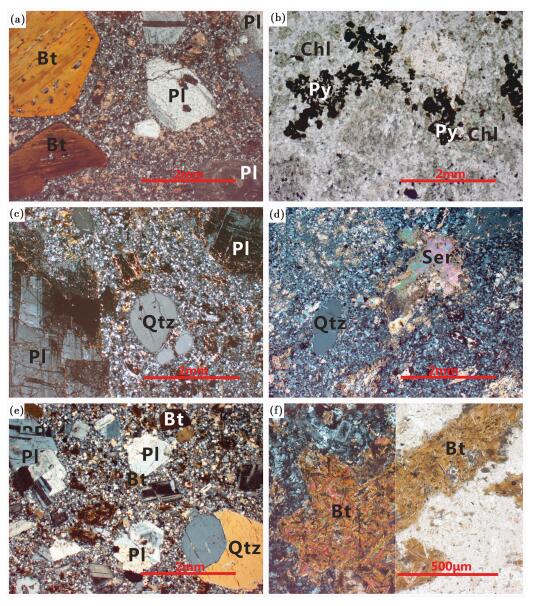
|
图 3 山上湾侵入岩岩石薄片照片, 示岩石结构及蚀变情况 (a)-SWW-1, 岩体Ⅰ石英闪长玢岩样品, 可见晶型完好的黑云母斑晶, 发育环带和聚片双晶的斜长石斑晶, 发生蚀变的暗色矿物斑晶以及少量石英斑晶, 正交偏光; (b)-SWW-2, 岩体Ⅱ石英闪长玢岩样品, 可见黄铁矿化蚀变以及绿泥石化蚀变, 单偏光; (c)-SWW-3, 岩体Ⅱ石英闪长玢岩样品, 可见发育环带和聚片双晶的斜长石斑晶, 熔蚀为浑圆状的石英斑晶以及发生蚀变的黑云母斑晶, 正交偏光; (d)-SWW-3, 岩体Ⅱ石英闪长玢岩样品, 可见斜长石斑晶发生绢云母化蚀变, 以及熔蚀为浑圆状的石英斑晶, 正交偏光; (e)-SWW-5, 岩体Ⅲ花岗闪长斑岩样品, 可见具聚片双晶的斜长石斑晶, 自形石英斑晶, 黑云母斑晶以及略具角闪石晶型的暗色蚀变矿物, 正交偏光; (f)-SWW-7, 岩体Ⅲ花岗闪长斑岩样品, 可见钾化蚀变, 原暗色矿物被新的细小的黑云母集合体取代, 仍保留原暗色矿物晶型, 左侧为正交偏光, 右侧为单偏光.矿物缩写:Pl-斜长石; Bt-黑云母; Py-黄铁矿; Chl-绿泥石; Qtz-石英; Ser-绢云母 Fig. 3 Microphotographs of polished thin sections from the Shanshangwan intrusive rocks, showing rock textures and alterations |
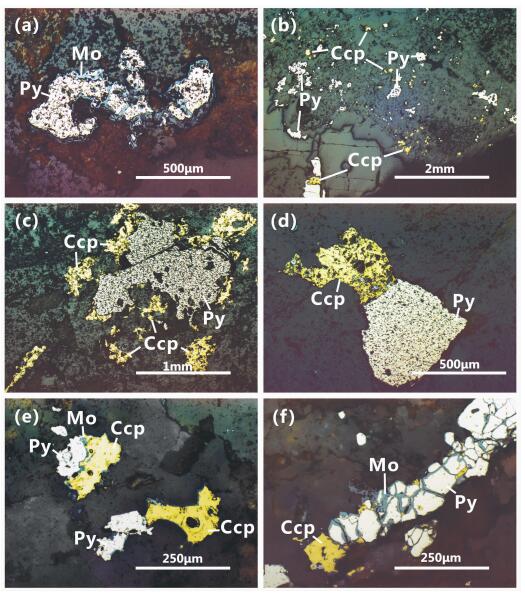
|
图 4 山上湾侵入岩岩石光片照片, 示硫化物矿化情况 (a)-SWW-3, 岩体Ⅱ石英闪长玢岩样品, 可见团块状黄铁矿化以及较晚的辉钼矿化围绕黄铁矿分布;(b)-SWW-6, 岩体Ⅲ花岗闪长斑岩样品, 可见星点状黄铁矿化及黄铜矿化;(c)-SWW-3, 岩体Ⅱ石英闪长玢岩样品, 可见浸染状, 细脉状黄铜矿化围绕团块状黄铁矿分布;(d)-SWW-6, 岩体Ⅲ花岗闪长斑岩样品, 可见黄铁矿与黄铜矿共生, 黄铜矿中包裹有较早形成的黄铁矿颗粒;(e)-SWW-5, 岩体Ⅲ花岗闪长斑岩样品, 粒状黄铁矿与黄铜矿共生, 晚期的辉钼矿化沿黄铁矿, 黄铜矿边缘及共生界面分布;(f)-SWW-7, 岩体Ⅲ花岗闪长斑岩样品, 可见粒状黄铜矿化, 脉状黄铁矿化包裹较早形成的黄铜矿颗粒, 以及更晚形成的沿裂隙面分布的辉钼矿化.矿物缩写:Py-黄铁矿;Mo-辉钼矿;Ccp-黄铜矿 Fig. 4 Microphotographs of polished rock slabs from the Shanshangwan intrusive rocks, showing sulfide mineralization |
挑选出山上湾矿区的代表性侵入岩样品磨制成电子探针薄片, 对其中的斜长石和黑云母斑晶, 用JEOL JXA-8100型电子探针仪进行矿物化学成份测定, 加速电压15kV, 电流强度10nA。
样品经人工破碎后, 按常规的重力和磁选方法分选出锆石, 最后在双目镜下挑纯。将选出的锆石颗粒制靶, 用于后续分析测试。在透射光和反射光显微观察的基础上, 选择合适的锆石颗粒进行阴极发光CL图像拍摄, 以便在做定年测试及Hf同位素分析时能知晓锆石内部结构并避开包裹体以及内部裂隙的干扰。锆石阴极发光CL图像拍摄使用加装Gatan MonoCL3+型阴极发光探头的JEOL JXA-8100型电子探针仪完成。锆石U-Pb定年则使用New Wave UP213激光剥蚀系统及Agilent 7500a型ICP-MS完成。ICP-MS的分析数据通过普通铅校正和计算后得到相应的同位素比值、年龄以及误差, 应用Isoplot 3.27程序完成谐和曲线绘制和年龄加权平均计算。锆石原位Hf同位素分析用New Wave UP213激光剥蚀系统和Thermo Fisher Neptune Plus MC-ICP-MS完成。详细分析流程见(侯可军等, 2007)。
对粉碎至200目的全岩粉末样品进行烧失量测定, 并采用熔片法经Thermo Scientific ARL Series XRF测试完成主量元素分析。微量元素和稀土元素的分析采用酸溶(HF+HNO3) 方法, 用Finnigan ElementⅡ型HR-ICP-MS测定, 相对标准偏差优于10%, 详细的分析方法参见(高剑峰等, 2003)。将测试微量元素所用的酸溶后样液留出一半用于Sr-Nd同位素分析, 经过Bio-Rad 50WX8阳离子交换树脂分离提纯出Sr和Nd, 然后使用Thermo Fisher Neptune Plus MC-ICP-MS测定其Sr和Nd同位素比值, 详细的同位素分离方法参见(濮巍等, 2005)。
样品有关的所有实验分析测试工作均在南京大学内生金属矿床成矿机制研究国家重点实验室完成。
3 分析结果 3.1 矿物化学对山上湾矿区三条岩脉中的黑云母斑晶进行的电子探针分析结果见表 1。在黑云母分类图(图 5a)(Foster, 1960) 中, 所有黑云母均位于区域3, 属富镁黑云母。在黑云母氧逸度图解(图 5b)(Wones and Eugster, 1965) 中, 山上湾矿区的黑云母均位于HM缓冲线以下, 低于武山花岗闪长斑岩体的氧逸度。斜长石的电子探针分析结果见表 2。斜长石牌号An值位于30~44之间, 平均值36, 在斜长石分类图中所有点均落于中长石范围(图 5c), 斜长石斑晶均具有浅成侵入岩中常发育的韵律环带。
|
|
表 1 山上湾侵入岩黑云母斑晶化学组成电子探针分析结果与结构计算(wt%) Table 1 Electron microprobe analyses and structural formula of biotites from the Shanshangwan intrusive rocks (wt%) |
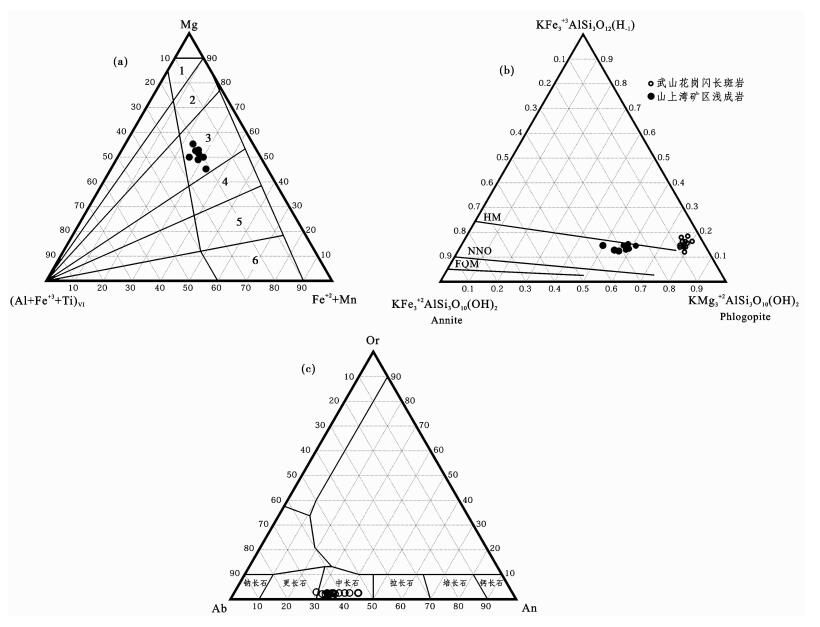
|
图 5 山上湾侵入岩矿物成分图解 (a)-黑云母分类图(底图据Foster, 1960):1-金云母; 2-铁金云母; 3-富镁黑云母; 4-镁铁黑云母; 5-富铁黑云母; 6-铁叶云母; (b)-黑云母氧逸度图解(底图据Wones and Eugster, 1965); 长石分类图(底图据Deer et al., 1992) Fig. 5 Classification diagram of biotite and feldspar from the Shanshangwan intrusive rocks (a)-ternary classification diagram of biotite (after Foster, 1960):1-phlogopite; 2-iron-phlogopite; 3-eastonite; 4-magnesio-biotite; 5-ferri-biotite; 6-annite; (b)-plot of Fe3+-Fe2+-Mg of biotites (after Wones and Eugster, 1965); (c)-ternary classification diagram of feldspar (after Deer et al., 1992) |
|
|
表 2 山上湾侵入岩长石斑晶化学组成电子探针分析结果与结构计算(wt%) Table 2 Electron microprobe analyses and structural formula of feldspar from the Shanshangwan intrusive rocks (wt%) |
分属三条岩脉的样品SSW-1、SSW-2及SSW-4的锆石U-Pb定年的结果列于表 3。
|
|
表 3 山上湾侵入岩锆石U-Pb定年结果 Table 3 Zircon U-Pb dating of the Shanshangwan intrusive rocks |
样品SSW-1、SSW-2及SSW-4的锆石晶形均较为完好, 透明度较高, 通常呈双锥长柱状, 在双目镜下可见锆石(100) 晶面发育。一般长100~300μm, 宽50~100μm, 长宽比约2:1~4:1。在CL图像(图 6) 中可见显著的岩浆震荡环带, 为典型的岩浆结晶锆石。锆石Th/U比值是判断变质锆石与岩浆锆石的一个重要标准。在流体中U的活动性强于Th, 变质流体往往富U贫Th, 因此变质锆石的Th/U < 0.1, 而岩浆锆石的Th/U比值一般大于0.1。山上湾的三个样品Th/U比值均大于0.1(表 3), 属于岩浆锆石范围(Belousova et al., 2002)。
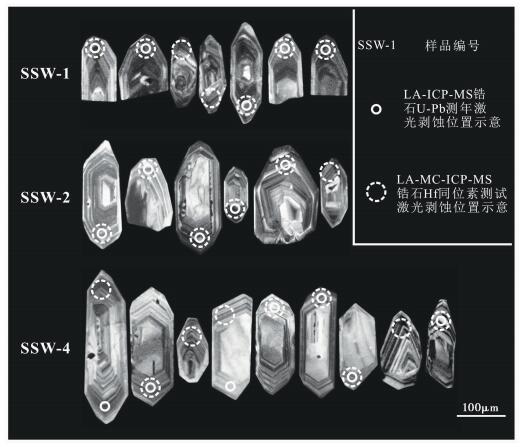
|
图 6 山上湾侵入岩代表性锆石CL图像及U-Pb年龄和Hf同位素分析靶位 Fig. 6 CL images of zircons from the Shanshangwan intrusive rocks, with marked locations for U-Pb dating and Hf isotope analyses |
样品SSW-1的锆石共分析了10个点, 除1个点打在残留锆石上给出较老的年龄外, 其余9个点(表 3) 的年龄比较一致, 206Pb/238U年龄变化在136~142Ma之间, 也全落在U-Pb年龄谐和线上(图 7), 给出的加权平均年龄为139.0±1.3Ma (n=9, MSWD=1.3)。
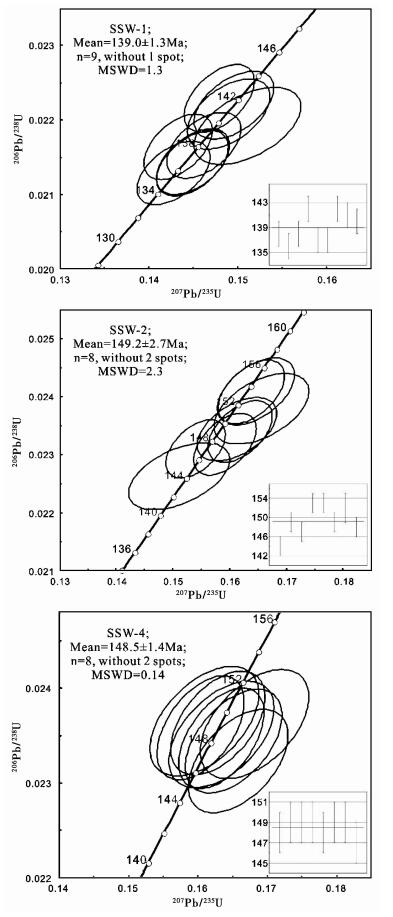
|
图 7 山上湾侵入岩锆石U-Pb谐和图 Fig. 7 Zircon U-Pb concordia diagrams of the Shanshangwan intrusive rocks |
样品SSW-2锆石共分析了10个点, 除1个点打在残留锆石上给出较老的年龄及1个点不谐和外, 其余8个点(表 3) 的年龄比较一致, 206Pb/238U年龄变化在144~153Ma之间, 全落在U-Pb年龄谐和线上(图 7), 给出的加权平均年龄为149.2±2.7Ma (n=8, MSWD=2.3)。
样品SSW-4锆石共分析了10个点, 除2个点不谐和外, 其余8个点(表 3) 的年龄非常一致, 206Pb/238U年龄变化在147~149Ma之间, 也全落在U-Pb年龄谐和线上(图 7), 给出的加权平均年龄为148.5±1.4Ma (n=8, MSWD=0.14)。
3.3 主量元素表 4列出了三条岩脉代表性样品的主量元素以及微量元素含量分析结果。
|
|
表 4 山上湾侵入岩主量元素(wt%) 和微量元素(×10-6) 分析结果 Table 4 Major (wt%) and trace element (×10-6) composi-tions of the Shanshangwan intrusive rocks |
该区岩浆岩具有以下特征:SiO2含量为58.8%~63.0%。结合浅成侵入岩的定名规则, 通过镜下对斑晶的矿物种类和相对含量的观察, 该区南面两条岩脉(Ⅰ、Ⅱ) 为石英闪长玢岩, 最北面的岩脉(Ⅲ) 为花岗闪长斑岩。虽然这三条岩脉SiO2含量差别并不大, 但由南向北表现出了轻微的酸性增强的趋势。K2O含量为1.9%~2.4%, 属高钾及中钾钙碱性岩石(图 8a)(Peccerillo and Taylor, 1976)。Al2O3为14.9%~16.2%, CaO为2.7%~5.0%, Na2O为3.6%~4.1%, 铝饱和指数A/CNK值为0.86~1.15, A/NK值为1.72~1.85, 属准铝质及过铝质范围(图 8b)(Maniar and Piccoli, 1989)。样品的MgO含量为2.0%~2.8%, Mg#为42~51。在主量元素哈克图解中(图 9), 除MnO和CaO外, 未见其它主量元素含量与SiO2变化表现出相关关系。
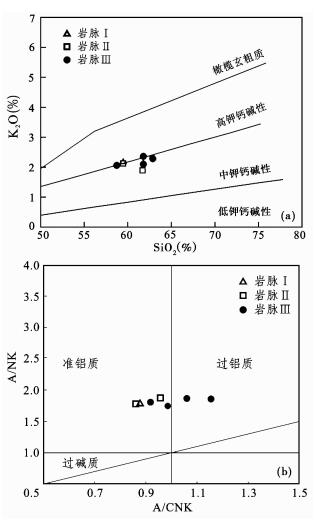
|
图 8 山上湾侵入岩SiO2 vs. K2O图解(a, 底图据Peccerillo and Taylor, 1976) 和A/NK vs. A/CNK图解(b, 底图据Maniar and Piccoli, 1989) Fig. 8 Plot of SiO2 vs. K2O (a, after Peccerillo and Taylor, 1976) and A/NK vs. A/CNK (b, after Maniar and Piccoli, 1989) of the Shanshangwan intrusive rocks |
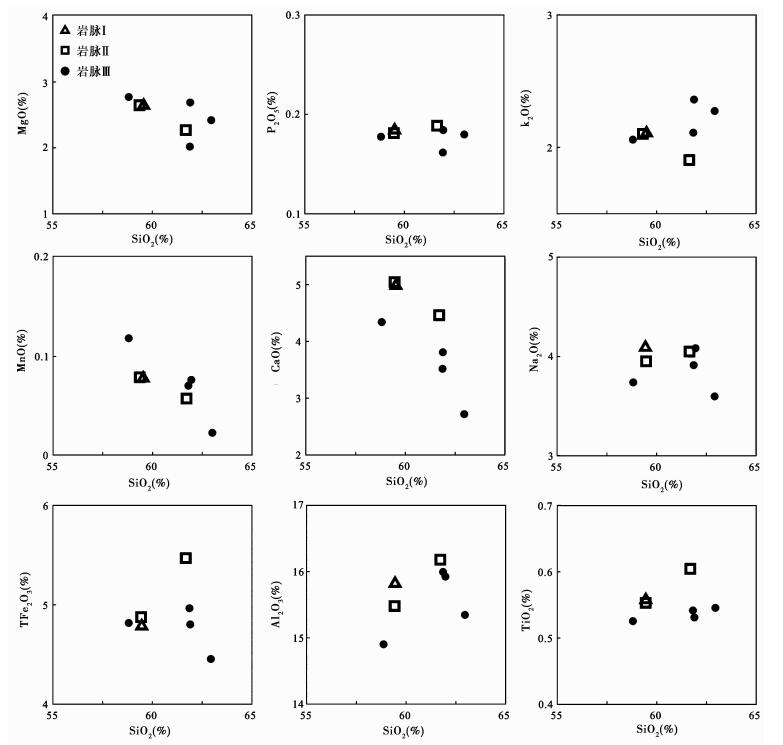
|
图 9 山上湾侵入岩主量元素哈克图解 Fig. 9 Plots of major elements vs. SiO2 for the Shanshangwan intrusive rocks |
山上湾矿区侵入岩稀土元素及其它微量元素分析结果见表 4。在表 4中以及经球粒陨石标准化(Sun and McDonough, 1989) 后的稀土元素配分曲线(图 10a) 和经原始地幔标准化(Sun and McDonough, 1989) 后的微量元素蛛网图(图 10b) 中可以看出, 该区岩石富集大离子亲石元素(Sr=380×10-6~555×10-6, 平均463×10-6) 及相容元素(Cr、Co、Ni、Ⅴ), 亏损高场强元素(Y=8.91×10-6~11.22×10-6, Nb=4.87×10-6~5.73×10-6, Ta=0.36×10-6~0.43×10-6), 无Sr负异常。轻稀土富集, 重稀土亏损, (La/Yb)N=14.31~18.96稀土总量为89.36×10-6~118.8×10-6, Eu/Eu*=0.98~1.13, 平均1.05, 无Eu负异常。
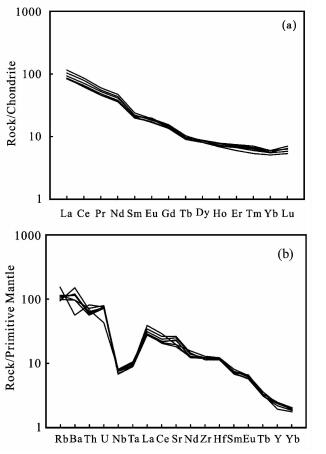
|
图 10 山上湾侵入岩球粒陨石标准化稀土元素配分曲线(a) 和原始地幔标准化微量元素蛛网图(b) Fig. 10 Chondrite-normalized REE pattern (a) and primitive mantle-normalized trace elements spidergram (b) of the Shanshangwan intrusive rocks |
本文对进行U-Pb定年的样品SSW-1、SSW-2和SSW-4中的锆石相应地进行了Hf同位素的测定, 结果如表 5和图 11(a, b) 所示。
|
|
表 5 山上湾侵入岩锆石原位Lu-Hf同位素LA-MC-ICP-MS分析结果 Table 5 LA-MC-ICP-MS in situ analysis of zircon Lu-Hf isotopic composition of the Shanshangwan intrusive rocks |
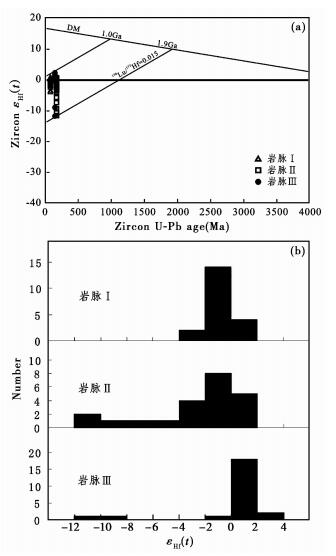
|
图 11 山上湾侵入岩锆石Hf同位素(εHf(t) 值) 随时间(锆石U-Pb年龄) 演化图解(a, 底图据Griffin et al., 2002) 和锆石εHf(t) 频次图(b) Fig. 11 a Plot of zircon εHf(t) values vs. U-Pb ages (a, after Griffin et al., 2002) and histogram of zircon εHf(t) values (b) of the Shanshangwan intrusive rocks |
山上湾三条岩脉的锆石初始176Hf/177Hf值在0.282359~0.282758之间, εHf(t) 值在-11.8~2.3之间(图 11a, b), 平均值为-1.1。计算的tDMC值为1.0Ga到1.9Ga, 平均值为1.2Ga。
进行数据处理时, 176Lu的衰变常数采用1.867×10-11a-1(Soderlund et al., 2004), εHf(t) 值的计算利用(Bouvier et al., 2008) 推荐的球粒陨石176Hf/177Hf比值(0.282785) 及176Lu/177Hf比值(0.0336), Hf模式年龄计算时采用当前亏损地幔的176Hf/177Hf比值(0.28325) 和176Lu/177Hf比值(0.0384)(Griffin et al., 2000), 采用的地壳参数176Hf/177Hf比值(0.015) 及176Lu/177Hf比值(0.015)(Griffin et al., 2002)。
3.6 Sr-Nd同位素Sr、Nd同位素分析结果见表 6和图 12。从表 6中可以看出, 山上湾矿区侵入岩初始87Sr/86Sr值变化在0.7060~0.7092之间, 平均0.7074, εNd(t) 值在-2.9~-2.0之间, 平均-2.3。利用两阶段模式计算出的Nd同位素模式年龄tDMC为1.1~1.2Ga。初始87Sr/86Sr值变化范围较大可能是岩石受到了一定蚀变作用的影响(图 12)。
|
|
表 6 山上湾侵入岩Sr、Nd同位素组成 Table 6 Nd and Sr isotopic compositions of the Shanshangwan intrusive rocks |
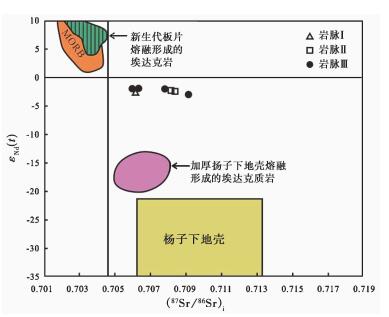
|
图 12 山上湾地区侵入岩Sr-Nd同位素组成图解 新生代板片熔融形成的埃达克岩据Defant and Kepezhinskas (2001); 加厚扬子下地壳来源的埃达克岩据Wang et al.(2007b), He et al.(2010), Guo et al.(2006); MORB据Hofmann (2003); 扬子下地壳据Jahn et al.(1999) Fig. 12 Initial 87Sr/86Sr vs. εNd(t) diagram for the Shanshangwan intrusive rocks Cenozoic slab-derived adakites (Defant and Kepezhinskas, 2001); thickened Yangtze lower crust-derived adakitic rocks (Wang et al., 2007b; He et al., 2010 and Guo et al., 2006); MORB (Hofmann, 2003) and Yangtze lower crust (Jahn et al., 1999) are shown for comparison |
εNd(t) 值的计算采用现代球粒陨石值(143Nd/144Nd)CHUR=0.512638(Goldstein et al., 1984), (147Sm/144Nd)CHUR=0.1967(Jacobsen and Wasserburg, 1980), 两阶段模式年龄tDMC的计算所用参数为(143Nd/144Nd)DM=0.513151, (147Sm/144Nd)DM=0.2136(Liew and Hofmann, 1988)。
4 讨论 4.1 成岩年龄及意义山上湾地区北面两条岩脉Ⅱ(149.2±2.7Ma) 和Ⅲ(148.5±1.4Ma) 的锆石年龄在误差范围内一致, 与武山、城门山等岩体的侵位年龄也较为接近(Ding et al., 2006; Yang et al., 2011)。而南面的岩体Ⅰ锆石年龄为139.0±1.3Ma, 比岩体Ⅱ和Ⅲ的侵位时间晚。在山上湾地区, 岩体Ⅱ和Ⅲ的黄铁矿化, 黄铜矿化, 以及其它蚀变都很发育, 而岩体Ⅰ则没有观察到矿化及相关的蚀变(由于样品有限, 不排除岩体Ⅰ西段有矿化), 因此, 根据现有样品, 初步推测在山上湾矿区与矿化关系密切的浅成岩脉应为149Ma左右侵位的一期, 而139Ma左右的侵入岩可能与矿化关系不密切。
4.2 岩石成因类型与物质来源初步探讨目前已有的研究认为, 长江中下游地区的燕山期侵入岩, 以及临近九瑞的大别地区的中酸性岩浆岩, 主要有以下几种成因:1) 由富集岩石圈地幔经AFC过程形成(Li et al., 2008, 2009; Xie et al., 2008, 2011; Yuan et al., 2011; 闫峻等, 2003), 2) 由洋脊俯冲过程中的洋壳部分熔融形成(Ling et al., 2009, 2011; Liu et al., 2010; Sun et al., 2010, 2011), 3) 由未经拆沉的加厚的下地壳部分熔融形成(He et al., 2011; Ling et al., 2011), 4) 由拆沉的加厚下地壳部分熔融形成(Wang et al., 2003, 2004a, b, 2006a, 2007a; 蒋少涌等, 2008; 李亮和蒋少涌, 2009)。下面针对山上湾矿区的岩浆岩, 进行初步讨论。
4.2.1 岩浆演化过程如果岩浆在上侵过程中受到了地壳物质的同化混染作用, 那么εNd(t) 值应随着SiO2的升高而降低, (87Sr/86Sr)i值则应该随着SiO2的升高而升高。由山上湾矿区的石英闪长玢岩, 花岗闪长斑岩的εNd(t) 值、87Sr/86Sr初始值与SiO2的协变图(图 13) 可以看出, εNd(t) 值和87Sr/86Sr初始值均没有与SiO2值表现出明显的相关关系。因此认为, 山上湾矿区的岩浆在演化过程中, 地壳物质同化混染作用的影响并不明显。
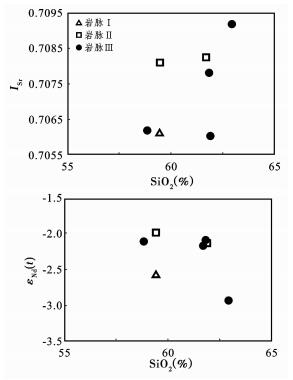
|
图 13 山上湾侵入岩SiO2 vs. εNd(t) 及SiO2 vs.(87Sr/86Sr)i图解 Fig. 13 Plot of SiO2 vs. εNd(t) values and (87Sr/86Sr)i ratios for the Shanshangwan intrusive rocks |
在岩石主量元素的哈克图解中, 除MnO, CaO随SiO2升高而降低外, MgO, K2O, P2O5, Al2O3, Na2O, TiO2以及Fe2O3T均没有表现出随SiO2的变化而变化的趋势, 这与分离结晶及岩浆混合所形成的岩石特征都不相符。若CaO的降低趋势是由斜长石的分离结晶所造成, 则微量元素Sr和Eu应表现出负异常, 这一点与山上湾地区侵入岩的微量元素特征相矛盾。另一方面, 在区别分离结晶与部分熔融作用的La/Yb-La图解(图 14) 中, 可以看到, 山上湾矿区的样品与部分熔融形成的岩石变化趋势非常一致, 而与分离结晶作用形成的岩石趋势明显不同。基于以上的讨论, 认为山上湾矿区的侵入岩是经部分熔融作用形成的, 与分离结晶后受同化混染作用(AFC) 不相关。
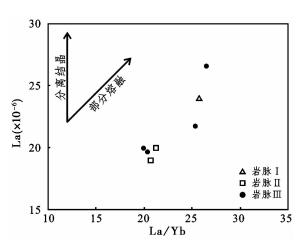
|
图 14 山上湾侵入岩La/Yb vs. La图解 Fig. 14 La/Y b vs. La diagram for the Shanshangwan intrusive rocks |
从山上湾地区岩石样品稀土元素配分曲线以及微量元素蛛网图(图 10) 中可以看出, 该区的石英闪长玢岩与花岗闪长斑岩均不具有Eu的负异常和Sr的负异常。结合主量元素中Al2O3和Na2O与SiO2不具相关关系的现象, 认为山上湾岩浆岩的源区不存在斜长石的残留。亏损重稀土Yb, 亏损高场强元素Y, 表明很可能有石榴石作为残留相在源区存在(Defant and Drummond, 1990)。由于石榴石是唯一能够明显分异中稀土和重稀土的造岩矿物(He et al., 2011; Huang and He, 2010), 因此, 在源区存在的石榴石能够同时升高部分熔融作用所形成的岩浆中的(La/Yb)N值和(Gd/Yb)N值(Blundy and Wood, 1994; He et al., 2011; Klein et al., 2000; Pertermann et al., 2004)。在图 15中可以看出, 山上湾矿区侵入岩的(La/Yb)N值和(Gd/Yb)N值显示出了正相关的关系, 符合源区存在石榴石的岩浆岩特征。基于以上的讨论, 认为山上湾地区的侵入岩源区没有斜长石残留, 而有石榴石存在。残留矿物相存在石榴石而不存在斜长石的岩浆源区通常被认为出现在大于40km的深部(压力>1.2GPa)(Petford and Atherton, 1996; Rapp and Watson, 1995)。因此, 山上湾侵入岩的形成, 应与加厚下地壳或俯冲洋壳的部分熔融有关, 而不是由富集岩石圈地幔经分离结晶同化混染作用所形成。
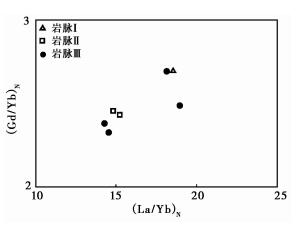
|
图 15 山上湾侵入岩(Gd/Yb)N vs.(La/Yb)N图解 Fig. 15 (Gd/Yb)N vs. (La/Yb)N diagram for Shanshangwan intrusive rocks |
已有的研究认为, 由富水洋壳经部分熔融作用所形成的岩浆含水量高, 粘度低, 向上穿过地幔的时间较短, 与地幔相互作用程度较弱。而由于加厚的下地壳以含水量低的榴辉岩相为主, 拆沉入软流圈地幔后, 熔融所形成的熔体将更为粘稠, 岩浆通过地幔岩的速度慢, 时间长, 与地幔相互作用强度大于俯冲洋壳的熔融产物(Lange, 1994; Liu et al., 2010)。未经拆沉作用的加厚下地壳部分熔融作用形成的熔体, 则基本未经历与地幔的相互作用。因此, 对于山上湾地区的侵入岩, 是由加厚下地壳部分熔融, 俯冲洋壳部分熔融, 或拆沉加厚下地壳部分熔融这三种岩石成因中的哪一种所形成, 可以通过以下地球化学特征来判断。
由于与地幔相互作用时间最长, 程度最强, 拆沉加厚下地壳部分熔融形成的岩浆岩应该具有相对高的MgO含量, Mg#(Rapp et al., 1999; Prouteau et al., 2001), 以及Cr, Co, Ni, V等相容元素含量。同位素方面则应具有较未经拆沉的加厚下地壳部分熔融岩石低的Sr初始值, 以及高的εNd(t) 值和εHf(t) 值。
通过MgO-SiO2图(图 16) 可以看出, 山上湾矿区的侵入岩具有相对较高的镁含量, 除一个样品外, 均落于拆沉下地壳部分熔融形成的岩石范围内(Xu et al., 2002; Gao et al., 2004; Wang et al., 2004a, b, 2006b)。但由于拆沉成因与俯冲板片熔融形成的岩石MgO含量范围有较大重叠, 故也有四个样品落在俯冲洋壳熔融形成的岩石范围内(Defant and Kepezhinskas, 2001)。山上湾矿区除两个样品外, 其余Mg#均大于45, 也与拆沉下地壳部分熔融形成的岩石相一致(图 16)(Gao et al., 2009)。同时该区石英闪长玢岩和花岗闪长斑岩的相容元素含量也较高。同位素方面(图 12), 山上湾矿区岩石的εNd(t) 值明显高于大别地区未经拆沉的加厚下地壳熔融形成的岩石(Jahn et al., 1999; Guo et al., 2006; Wang et al., 2007b; He et al., 2010)。山上湾侵入岩的87Sr/86Sr初始值高于俯冲洋壳部分熔融形成的岩石, 虽然海水蚀变能够增高俯冲洋壳的87Sr/86Sr初始值, 但不能改变εNd(t) 值(Menzies et al., 1993), 而山上湾岩石的εNd(t) 值也明显低于俯冲洋壳部分熔融形成的岩石(Defant et al., 1992; Kay et al., 1993; Aguillón-Robles et al., 2001)。山上湾岩石中锆石εHf(t) 值达到了-1.1左右, 由此也可以看出拆沉的加厚下地壳与软流圈地幔相互作用程度较强。因此, 根据山上湾地区的岩石地球化学特征及同位素地球化学特征可以判断, 该区的石英闪长玢岩及花岗闪长斑岩很可能是由加厚下地壳拆沉入软流圈地幔后, 发生部分熔融, 熔体与地幔发生强烈的相互作用后, 最终上侵定位的过程所形成的。
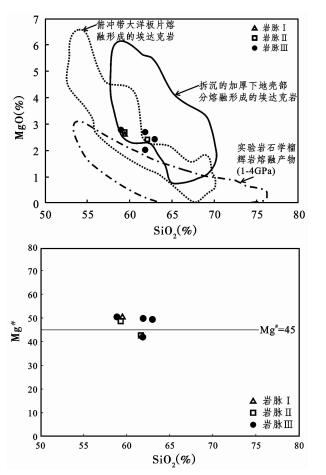
|
图 16 山上湾侵入岩MgO vs. SiO2和Mg# vs SiO2图解 Fig. 16 Plots of MgO vs. SiO2 and Mg# vs SiO2 for the Shanshangwan intrusive rocks |
山上湾地区矿化蚀变明显的两条岩脉的成岩年龄与九瑞地区其它与成矿相关的花岗闪长斑岩一致, 而它们的岩石地球化学特征, 同位素地球化学特征也相近, 表明其经历了非常近似的成岩过程。与单纯的加厚下地壳熔融形成的岩石不同, 由于拆沉作用形成的岩浆岩经历了强烈的壳幔相互作用, 因此原本赋存在地幔橄榄岩中的Cu、Au等成矿元素可被氧化进入到熔体中, 在随后的岩浆上侵及期后热液演化过程中, 才能够在合适的条件下卸载Cu、Au元素并富集沉淀成矿, 为矿床的形成提供成矿金属来源。
山上湾地区的石英闪长玢岩及花岗闪长斑岩具有九瑞地区成矿岩石所需满足的成岩过程, 在地表露头也已经发现了明显的矿化及蚀变, 而该区志留系粉砂岩覆盖在奥陶系灰岩之上, 因此, 在深部石英闪长玢岩及花岗闪长斑岩与奥陶系灰岩的内外接触带上, 以及靠近岩体的奥陶系与志留系地层接触界面处, 都是利于岩浆热液运移及矿质沉淀富集的理想场所, 应在今后找矿工作中给予重点关注。
5 结论(1) 山上湾矿区北面的两条矿化蚀变明显的岩脉的侵位年龄为149.2±2.7Ma和148.5±1.4Ma, 与九瑞地区其它与成矿相关的岩体(如城门山、武山) 年龄一致。而南面未见矿化的岩脉侵位年龄为139.0±1.3Ma。
(2) 山上湾矿区石英闪长玢岩及花岗闪长斑岩的岩石地球化学特征, 以及同位素地球化学特征与九瑞地区其它与成矿相关的岩体相一致, 认为经历了相似的成岩过程, 很可能为加厚的下地壳拆沉入软流圈地幔后, 发生部分熔融, 熔体在上侵过程中与地幔发生了强烈混染, 最终形成了具有明显的壳幔混源特征的岩石。
(3) 目前已经在山上湾矿区的一些石英闪长玢岩及花岗闪长斑岩地表露头中发现了多种蚀变现象以及铜的矿化, 加之成岩年龄及岩石成因与九瑞其它成矿岩石相同, 因此, 在深部岩体与奥陶系灰岩的内外接触带上, 以及靠近岩体的奥陶纪与志留纪地层接触界面处, 具有较大的成矿潜力, 值得进一步的勘查工作。
致谢 野外工作得到了江西省国土资源厅、江西地质矿产勘查开发局和赣西北地质大队的大力支持, 作者在此深表谢意。感谢南京大学孙岩、边立曾等教授对本工作的指导及对本文提出的宝贵修改建议。感谢两位匿名审稿人的评阅意见。| [] | Aguillón-Robles A, Calmus T, Benoit M, Bellon H, Maury RC, Cotten J, Bourgois J, Michaud F. 2001. Late Miocene adakites and Nb-enriched basalts from Vizcaino Peninsula, Mexico: Indicators of East Pacific Rise subduction below Southern Baja California. Geology, 29(6): 531–534. DOI:10.1130/0091-7613(2001)029<0531:LMAANE>2.0.CO;2 |
| [] | Belousova EA, Griffin WL, O'Reilly SY, Fisher NI. 2002. Igneous zircon: Trace element composition as an indicator of source rock type. Contributions to Mineralogy and Petrology, 143(5): 602–622. DOI:10.1007/s00410-002-0364-7 |
| [] | Blundy J, Wood B. 1994. Prediction of crystal-melt partition coefficients from elastic moduli. Nature, 372(6505): 452–454. DOI:10.1038/372452a0 |
| [] | Bouvier A, Vervoort JD, Patchett PJ. 2008. The Lu-Hf and Sm-Nd isotopic composition of CHUR: Constraints from unequilibrated chondrites and implications for the bulk composition of terrestrial planets. Earth and Planetary Science Letters, 273(1-2): 48–57. DOI:10.1016/j.epsl.2008.06.010 |
| [] | Chen ZH, Xing GF, Guo KY, Zeng Y, Kuang FX, He ZY, Ke X, Yu MG, Zhao XL, Zhang Y. 2011. Zircon U-Pb ages of ore-bearing granitic bodies in northern Jiujiang-Ruichang metallogenic district of the mineralization belt of the Middle-Lower Reaches of the Yangtze River, and its geological significance. Acta Geologica Sinica, 85(7): 1146–1158. |
| [] | Deer WA, Howie RA, Zussman J. 1992. An Introduction to the Rock-Forming Minerals. 2nd Edition. Harlow, UK: Longman Group UK, 232. |
| [] | Defant MJ, Drummond MS. 1990. Derivation of some modern arc magmas by melting of young subducted lithosphere. Nature, 347(6294): 662–665. DOI:10.1038/347662a0 |
| [] | Defant MJ, Jackson TE, Drummond MS, Deboer JZ, Bellon H, Feigenson MD, Maury RC, Stewart RH. 1992. The geochemistry of young volcanism throughout Western Panama and Southeastern Costa-Rica: An overview. Journal of the Geological Society, 149(4): 569–579. DOI:10.1144/gsjgs.149.4.0569 |
| [] | Defant MJ, Kepezhinskas P. 2001. Evidence suggests slab melting in arc magmas. EOS (Transactions, American Geophysical Union), 82(6): 65–69. |
| [] | Ding X, Jiang SY, Zhao KD, Nakamura E, Kobayashi K, Ni P, Gu LX, Jiang YH. 2006. In-situ U-Pb SIMS dating and trace element (EMPA) composition of zircon from a granodiorite porphyry in the Wushan copper deposit, China. Mineralogy and Petrology, 86(1-2): 29–44. DOI:10.1007/s00710-005-0093-5 |
| [] | Foster MD. 1960. Interpretation of the composition of trioctahedral micas. U. S. Geological Survey Professional Paper, 354-B: 11-48 |
| [] | Gao JF, Lu JJ, Lai MY, Lin YP, Pu W. 2003. Analysis of trace elements in rock samples using HR-ICPMS. Journal of Nanjing University (Natural Sciences), 39(6): 844–850. |
| [] | Gao S, Rudnick RL, Yuan HL, Liu XM, Liu YS, Xu WL, Ling WL, Ayers J, Wang XC, Wang QH. 2004. Recycling lower continental crust in the North China craton. Nature, 432(7019): 892–897. DOI:10.1038/nature03162 |
| [] | Gao S, Zhang JF, Xu WL, Liu YS. 2009. Delamination and destruction of the North China Craton. Chinese Science Bulletin, 54(19): 3367–3378. |
| [] | Goldstein SL, Onions RK, Hamilton PJ. 1984. A Sm-Nd isotopic study of atmospheric dusts and particulates from major river systems. Earth and Planetary Science Letters, 70(2): 221–236. DOI:10.1016/0012-821X(84)90007-4 |
| [] | Griffin WL, Pearson NJ, Belousova E, Jackson SE, van Achterbergh E, O'Reilly SY, Shee SR. 2000. The Hf isotope composition of cratonic mantle: LAM-MC-ICPMS analysis of zircon megacrysts in kimberlites. Geochimica et Cosmochimica Acta, 64(1): 133–147. DOI:10.1016/S0016-7037(99)00343-9 |
| [] | Griffin WL, Wang X, Jackson SE, Pearson NJ, O'Reilly SY, Xu XS, Zhou XM. 2002. Zircon chemistry and magma mixing, SE China: In-situ analysis of Hf isotopes, Tonglu and Pingtan igneous complexes. Lithos, 61(3-4): 237–269. DOI:10.1016/S0024-4937(02)00082-8 |
| [] | Guo F, Fan WM, Li CW. 2006. Geochemistry of late Mesozoic adakites from the Sulu belt, eastern China: Magma genesis and implications for crustal recycling beneath continental collisional orogens. Geological Magazine, 143(1): 1–13. |
| [] | He YS, Li SG, Hoefs J, Huang F, Liu SA. 2010. Partial melts from thick lower continental crust: Geochemical characterization and identification. Geochimica et Cosmochimica Acta, 74(12): A392–A392. |
| [] | He YS, Li SG, Hoefs J, Huang F, Liu SA, Hou ZH. 2011. Post-collisional granitoids from the Dabie orogen: New evidence for partial melting of a thickened continental crust. Geochimica et Cosmochimica Acta, 75(13): 3815–3838. DOI:10.1016/j.gca.2011.04.011 |
| [] | Hofmann AW. 2003. Sampling mantle heterogeneity through oceanic basalts: Isotopes and trace elements. In: Carlson RW (ed.). Treatise on Geochemistry. Oxford: Elservier-Pergamon, 61-101 |
| [] | Hou KJ, Li YH, Zou TR, Qu XM, Shi YR, Xie GQ. 2007. Laser ablation-MC-ICP-MS technique for Hf isotope microanalysis of zircon and its geological applications. Acta Petrologica Sinica, 23(10): 2595–2604. |
| [] | Huang EB, Zhang NT, Luo ZS. 1990. The genesis of the Chengmenshan and Wushan copper deposits. Mineral Deposits, 9(4): 291–308. |
| [] | Huang F, He YS. 2010. Partial melting of the dry mafic continental crust: Implications for petrogenesis of C-type adakites. Chinese Science Bulletin, 55(22): 2428–2439. DOI:10.1007/s11434-010-3224-2 |
| [] | Jacobsen SB, Wasserburg GJ. 1980. Sm-Nd isotopic evolution of chondrites. Earth and Planetary Science Letters, 50(1): 139–155. DOI:10.1016/0012-821X(80)90125-9 |
| [] | Jahn BM, Wu FY, Lo CH, Tsai CH. 1999. Crust-mantle interaction induced by deep subduction of the continental crust: Geochemical and Sr-Nd isotopic evidence from post-collisional mafic-ultramafic intrusions of the northern Dabie complex, central China. Chemical Geology, 157(1-2): 119–146. DOI:10.1016/S0009-2541(98)00197-1 |
| [] | Jiang SY, Li L, Zhu B, Ding X, Jiang YH, Gu LX, Ni P. 2008. Geochemical and Sr-Nd-Hf isotopic compositions of granodiorite from the Wushan copper deposit, Jiangxi Province and their implications for petrogenesis. Acta Petrologica Sinica, 24(8): 1679–1690. |
| [] | Kay SM, Ramos VA, Marquez M. 1993. Evidence in Cerro Pampa volcanic rocks for slab-melting prior to ridge-trench collision in Southern South America. Journal of Geology, 101(6): 703–714. DOI:10.1086/648269 |
| [] | Klein M, Stosch HG, Seck HA, Shimizu N. 2000. Experimental partitioning of high field strength and rare earth elements between clinopyroxene and garnet in andesitic to tonalitic systems. Geochimica et Cosmochimica Acta, 64(1): 99–115. DOI:10.1016/S0016-7037(99)00178-7 |
| [] | Lange RA. 1994. The effect of H2O, CO2 and F on the density and viscosity of silicate melts. In: Carroll MR and Holloway JR (eds.). Volatiles in Magmas. Reviews in Mineralogy and Geochemistry, 30: 331-369 |
| [] | Li JW, Zhao XF, Zhou MF, Vasconcelos P, Ma CQ, Deng XD, de Souza ZS, Zhao YX, Wu G. 2008. Origin of the Tongshankou porphyry-skarn Cu-Mo deposit, eastern Yangtze craton, Eastern China: Geochronological, geochemical, and Sr-Nd-Hf isotopic constraints. Mineralium Deposita, 43(3): 315–336. DOI:10.1007/s00126-007-0161-3 |
| [] | Li JW, Zhao XF, Zhou MF, Ma CQ, de Souza ZS, Vasconcelos P. 2009. Late Mesozoic magmatism from the Daye region, eastern China: U-Pb ages, petrogenesis, and geodynamic implications. Contributions to Mineralogy and Petrology, 157(3): 383–409. DOI:10.1007/s00410-008-0341-x |
| [] | Li L, Jiang SY. 2009. Petrogenesis and geochemistry of the Dengjiashan porphyritic granodiorite, Jiujiang-Ruichang metallogenic district of the Middle-Lower Reaches of the Yangtze River. Acta Petrologica Sinica, 25(11): 2877–2888. |
| [] | Li XH, Li WX, Wang XC, Li QL, Liu Y, Tang GQ, Gao YY, Wu FY. 2010. SIMS U-Pb zircon geochronology of porphyry Cu-Au-(Mo) deposits in the Yangtze River Metallogenic Belt, eastern China: Magmatic response to Early Cretaceous lithospheric extension. Lithos, 119(3-4): 427–438. DOI:10.1016/j.lithos.2010.07.018 |
| [] | Liew TC, Hofmann AW. 1988. Precambrian crustal components, plutonic associations, plate environment of the Hercynian fold belt of Central-Europe: Indications from a Nd and Sr isotopic study. Contributions to Mineralogy and Petrology, 98(2): 129–138. DOI:10.1007/BF00402106 |
| [] | Ling MX, Wang FY, Ding X, Hu YH, Zhou JB, Zartman RE, Yang XY, Sun WD. 2009. Cretaceous ridge subduction along the Lower Yangtze River Belt, Eastern China. Economic Geology, 104(2): 303–321. DOI:10.2113/gsecongeo.104.2.303 |
| [] | Ling MX, Wang FY, Ding X, Zhou JB, Sun WD. 2011. Different origins of adakites from the Dabie Mountains and the Lower Yangtze River Belt, eastern China: Geochemical constraints. International Geology Review, 53(5-6): 727–740. DOI:10.1080/00206814.2010.482349 |
| [] | Liu SA, Li SG, He YS, Huang F. 2010. Geochemical contrasts between Early Cretaceous ore-bearing and ore-barren high-Mg adakites in central-eastern China: Implications for petrogenesis and Cu-Au mineralization. Geochimica et Cosmochimica Acta, 74(24): 7160–7178. DOI:10.1016/j.gca.2010.09.003 |
| [] | Liu X. 1990. The mechanism of structural control of ore formation and geochemical characteristics in the massive sulfide deposits of the Wushan copper ore field, Jiangxi. Acta Geologica Sinica(1): 22–32. |
| [] | Maniar PD, Piccoli PM. 1989. Tectonic discrimination of granitoids. Geological Society of America Bulletin, 101(5): 635–643. DOI:10.1130/0016-7606(1989)101<0635:TDOG>2.3.CO;2 |
| [] | Menzies MA, Long A, Ingram G, Tatnell M, Janecky D. 1993. MORB peridotite-sea water interaction: Experimental constraints on the behaviour of trace elements, 87Sr/86Sr and 143Nd/144Nd ratios. Geological Society, London, Special Publications, 76(1): 309–322. DOI:10.1144/GSL.SP.1993.076.01.15 |
| [] | Peccerillo A, Taylor SR. 1976. Geochemistry of eocene calc-alkaline volcanic rocks from the Kastamonu Area, Northern Turkey. Contributions to Mineralogy and Petrology, 58(1): 63–81. DOI:10.1007/BF00384745 |
| [] | Pertermann M, Hirschmann MM, Hametner K, Günther D, Schmidt MW. 2004. Experimental determination of trace element partitioning between garnet and silica-rich liquid during anhydrous partial melting of MORB-like eclogite. Geochemistry Geophysics Geosystems, 5: Q05A01. DOI:10.1029/2003GC000638 |
| [] | Petford N, Atherton M. 1996. Na-rich partial melts from newly underplated basaltic crust: The Cordillera Blanca Batholith, Peru. Journal of Petrology, 37(6): 1491–1521. DOI:10.1093/petrology/37.6.1491 |
| [] | Prouteau G, Scaillet B, Pichavant M, Maury R. 2001. Evidence for mantle metasomatism by hydrous silicic melts derived from subducted oceanic crust. Nature, 410(6825): 197–200. DOI:10.1038/35065583 |
| [] | Pu W, Gao J, Zhao KD, Ling HF, Jiang SY. 2005. Separation method of Rb-Sr, Sm-Nd using DCTA and HIBA. Journal of Nanjing University (Natural Sciences), 41(4): 445–450. |
| [] | Rapp RP, Watson EB. 1995. Dehydration melting of metabasalt at 8~32kbar: Implications for continental growth and crust-mantle recycling. Journal of Petrology, 36(4): 891–931. DOI:10.1093/petrology/36.4.891 |
| [] | Rapp RP, Shimizu N, Norman MD, Applegate GS. 1999. Reaction between slab-derived melts and peridotite in the mantle wedge: Experimental constraints at 3.8GPa. Chemical Geology, 160(4): 335–356. DOI:10.1016/S0009-2541(99)00106-0 |
| [] | Soderlund U, Patchett JP, Vervoort JD, Isachsen CE. 2004. The 176Lu decay constant determined by Lu-Hf and U-Pb isotope systematics of Precambrian mafic intrusions. Earth and Planetary Science Letters, 219(3-4): 311–324. DOI:10.1016/S0012-821X(04)00012-3 |
| [] | Sun SS and McDonough WF. 1989. Chemical and isotopic systematics of oceanic basalts: Implications for mantle composition and processes. In: Saunders AD and Norry MJ (eds.). Magmatism in Oceanic Basins. Geological Society, London, Special Publications, 42(1): 313-345 |
| [] | Sun WD, Ling MX, Yang XY, Fan WM, Ding X, Liang HY. 2010. Ridge subduction and porphyry copper-gold mineralization: An overview. Science China (Earth Sciences), 53(4): 475–484. DOI:10.1007/s11430-010-0024-0 |
| [] | Sun WD, Zhang H, Ling MX, Ding X, Chung SL, Zhou JB, Yang XY, Fan WM. 2011. The genetic association of adakites and Cu-Au ore deposits. International Geology Review, 53(5-6): 691–703. DOI:10.1080/00206814.2010.507362 |
| [] | Wang Q, Zhao ZH, Xu JF, Li XH, Bao ZW, Xiong XL, Liu YM. 2003. Petrogenesis and metallogenesis of the Yanshanian adakite-like rocks in the Eastern Yangtze Block. Science in China (Earth Sciences), 46(Suppl): 164–176. |
| [] | Wang Q, Xu JF, Zhao ZH, Bao ZW, Xu W, Xiong XL. 2004a. Cretaceous high-potassium intrusive rocks in the Yueshan-Hongzhen area of East China: Adakites in an extensional tectonic regime within a continent. Geochemical Journal, 38(5): 417–434. DOI:10.2343/geochemj.38.417 |
| [] | Wang Q, Zhao ZH, Bao ZW, Xu JF, Liu W, Li CF, Bai ZH, Xiong XL. 2004b. Geochemistry and petrogenesis of the Tongshankou and Yinzu adakitic intrusive rocks and the associated porphyry copper-molybdenum mineralization in southeast Hubei, East China. Resource Geology, 54(2): 137–152. DOI:10.1111/rge.2004.54.issue-2 |
| [] | Wang Q, Wyman DA, Xu JF, Zhao ZH, Jian P, Xiong XL, Bao ZW, Li CF, Bai ZH. 2006a. Petrogenesis of Cretaceous adakitic and shoshonitic igneous rocks in the Luzong area, Anhui Province (eastern China): Implications for geodynamics and Cu-Au mineralization. Lithos, 89(3-4): 424–446. DOI:10.1016/j.lithos.2005.12.010 |
| [] | Wang Q, Xu JF, Jian P, Bao ZW, Zhao ZH, Li CF, Xiong XL, Ma JL. 2006b. Petrogenesis of adakitic porphyries in an extensional tectonic setting, Dexing, South China: Implications for the genesis of porphyry copper mineralization. Journal of Petrology, 47(1): 119–144. |
| [] | Wang Q, Wyman DA, Xu JF, Zhao ZH, Jian P, Zi F. 2007a. Partial melting of thickened or delaminated lower crust in the middle of eastern China: Implications for Cu-Au mineralization. Journal of Geology, 115(2): 149–161. DOI:10.1086/510643 |
| [] | Wang Q, Wyman DA, Xu JF, Jian P, Zhao ZH, Li CF, Xu W, Ma JL, He B. 2007b. Early Cretaceous adakitic granites in the Northern Dabie Complex, central China: Implications for partial melting and delamination of thickened lower crust. Geochimica Et Cosmochimica Acta, 71(10): 2609–2636. DOI:10.1016/j.gca.2007.03.008 |
| [] | Wones DR, Eugster HP. 1965. Stability of biotite-experiment theory and application. American Mineralogist, 50(9): 1228–1272. |
| [] | Xie GQ, Mao JW, Li RL, Bierlein FP. 2008. Geochemistry and Nd-Sr isotopic studies of Late Mesozoic granitoids in the southeastern Hubei Province, Middle-Lower Yangtze River belt, Eastern China: Petrogenesis and tectonic setting. Lithos, 104(1-4): 216–230. DOI:10.1016/j.lithos.2007.12.008 |
| [] | Xie GQ, Mao JW, Zhao HJ. 2011. Zircon U-Pb geochronological and Hf isotopic constraints on petrogenesis of Late Mesozoic intrusions in the southeast Hubei Province, Middle-Lower Yangtze River belt (MLYRB), East China. Lithos, 125(1-2): 693–710. DOI:10.1016/j.lithos.2011.04.001 |
| [] | Xu JF, Shinjo R, Defant MJ, Wang Q, Rapp RP. 2002. Origin of Mesozoic adakitic intrusive rocks in the Ningzhen area of East China: Partial melting of delaminated lower continental crust. Geology, 30(12): 1111–1114. DOI:10.1130/0091-7613(2002)030<1111:OOMAIR>2.0.CO;2 |
| [] | Yan J, Chen YJ, Yu JF, Qian TH, Zhou TX. 2003. Pb isotopic characteristics of Late Mesozoic mafic rocks from the Lower Yangtze region: Evidence for enriched mantle. Geological Journal of China Universities, 9(2): 195–206. |
| [] | Yang SY, Jiang SY, Li L, Sun Y, Sun MZ, Bian LZ, Xiong YG, Cao ZQ. 2011. Late Mesozoic magmatism of the Jiurui mineralization district in the Middle-Lower Yangtze River Metallogenic Belt, Eastern China: Precise U-Pb ages and geodynamic implications. Gondwana Research, 20(4): 831–843. DOI:10.1016/j.gr.2011.03.012 |
| [] | Yuan F, Zhou TF, Liu J, Fan Y, Cooke DR, Jowitt SM. 2011. Petrogenesis of volcanic and intrusive rocks of the Zhuanqiao stage, Luzong Basin, Yangtze metallogenic belt, East China: Implications for ore deposition. International Geology Review, 53(5-6): 526–541. DOI:10.1080/00206814.2010.496246 |
| [] | Zhai YS, Yao SZ, Lin XD, et al. 1992. The Metallogenic Features of Fe and Cu (Au) in the Middle and Lower Reaches of the Changjiang River. Beijing: Geological Publishing House: 1-235. |
| [] | Zhai YS, Yao SZ, Zhou ZG. 1999. Research on Orefield Tectonics of Copper and Gold Deposits in the Middle-Lower Reaches of the Yangtze River. Wuhan: China University of Geosciences Press: 1-195. |
| [] | 陈志洪, 邢光福, 郭坤一, 曾勇, 匡福祥, 贺振宇, 柯学, 余明刚, 赵希林, 张勇. 2011. 长江中下游成矿带九瑞矿集区(北部) 含矿岩体的锆石U-Pb定年及其地质意义. 地质学报, 85(7): 1146–1158. |
| [] | 高剑峰, 陆建军, 赖鸣远, 林雨萍, 濮巍. 2003. 岩石样品中微量元素的高分辨率等离子质谱分析. 南京大学学报(自然科学版), 39(6): 844–850. |
| [] | 侯可军, 李延河, 邹天人, 曲晓明, 石玉若, 谢桂青. 2007. LA-MC-ICP-MS锆石Hf同位素的分析方法及地质应用. 岩石学报, 23(10): 2595–2604. |
| [] | 黄恩邦, 张迺堂, 罗钊生. 1990. 城门山、武山铜矿床成因. 矿床地质, 9(4): 291–300. |
| [] | 蒋少涌, 李亮, 朱碧, 丁昕, 姜耀辉, 顾连兴, 倪培. 2008. 江西武山铜矿区花岗闪长斑岩的地球化学和Sr-Nd-Hf同位素组成及成因探讨. 岩石学报, 24(8): 1679–1690. |
| [] | 李亮, 蒋少涌. 2009. 长江中下游地区九瑞矿集区邓家山花岗闪长斑岩的地球化学与成因研究. 岩石学报, 25(11): 2877–2888. |
| [] | 刘迅. 1990. 江西武山铜矿田块状硫化物矿床的构造控矿机制及地球化学特征. 地质学报(1): 22–32. |
| [] | 濮巍, 高剑峰, 赵葵东, 凌洪飞, 蒋少涌. 2005. 利用DCTA和HIBA快速有效分离Rb-Sr、Sm-Nd的方法. 南京大学学报(自然科学版), 41(4): 445–450. |
| [] | 闫峻, 陈江峰, 喻钢, 钱卉, 周泰禧. 2003. 长江中下游晚中生代中基性岩的铅同位素特征:富集地幔的证据. 高校地质学报, 9(2): 195–206. |
| [] | 翟裕生, 姚书振, 林新多, 等. 1992. 长江中下游地区铁铜(金) 成矿规律. 北京: 地质出版社: 1-235. |
| [] | 翟裕生, 姚书振, 周宗桂. 1999. 长江中下游铜金矿床矿田构造. 武汉: 中国地质大学出版社: 1-195. |
 2012, Vol. 28
2012, Vol. 28



